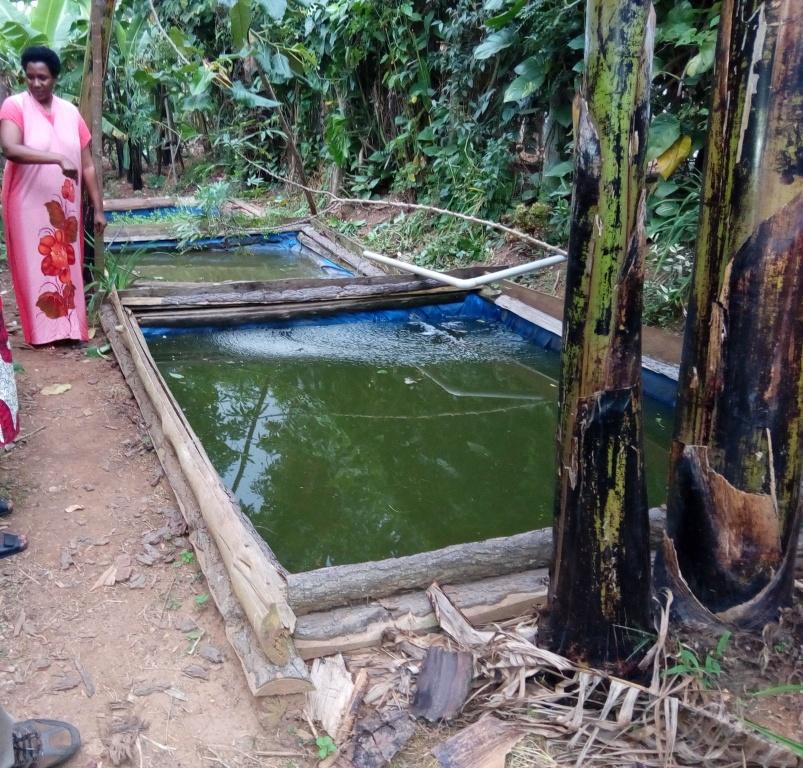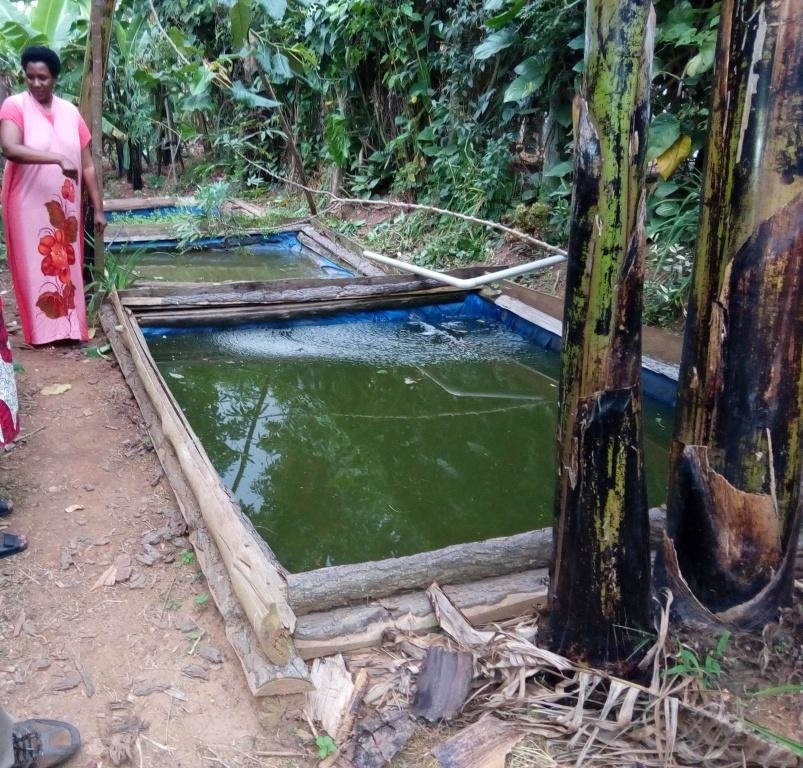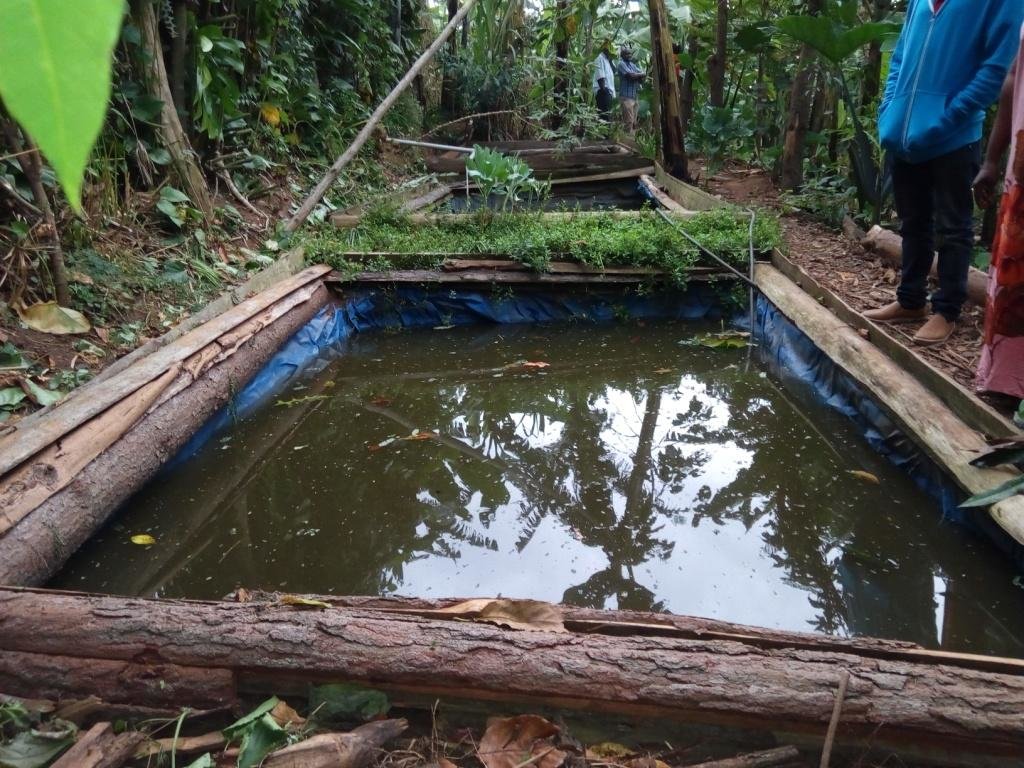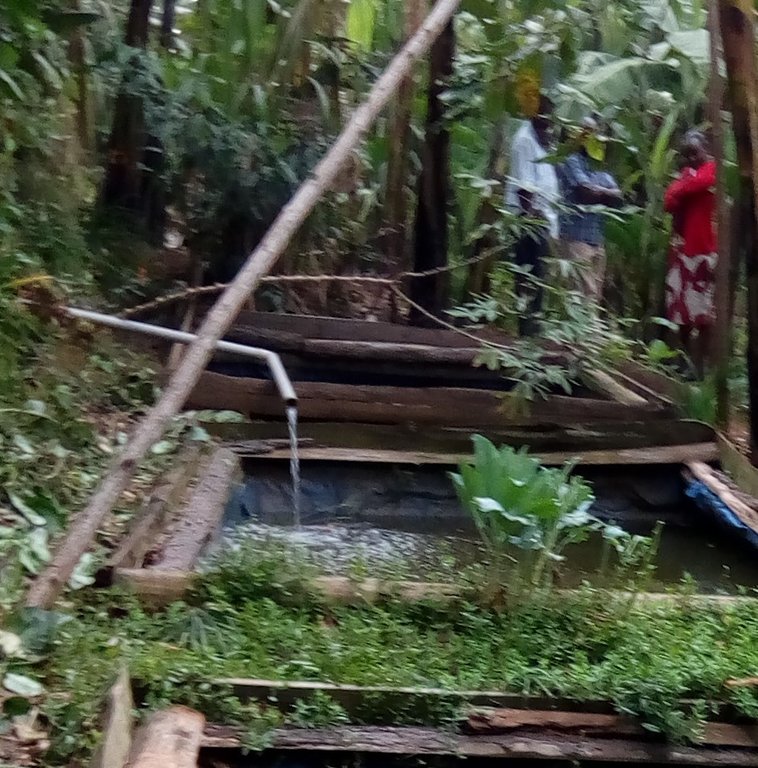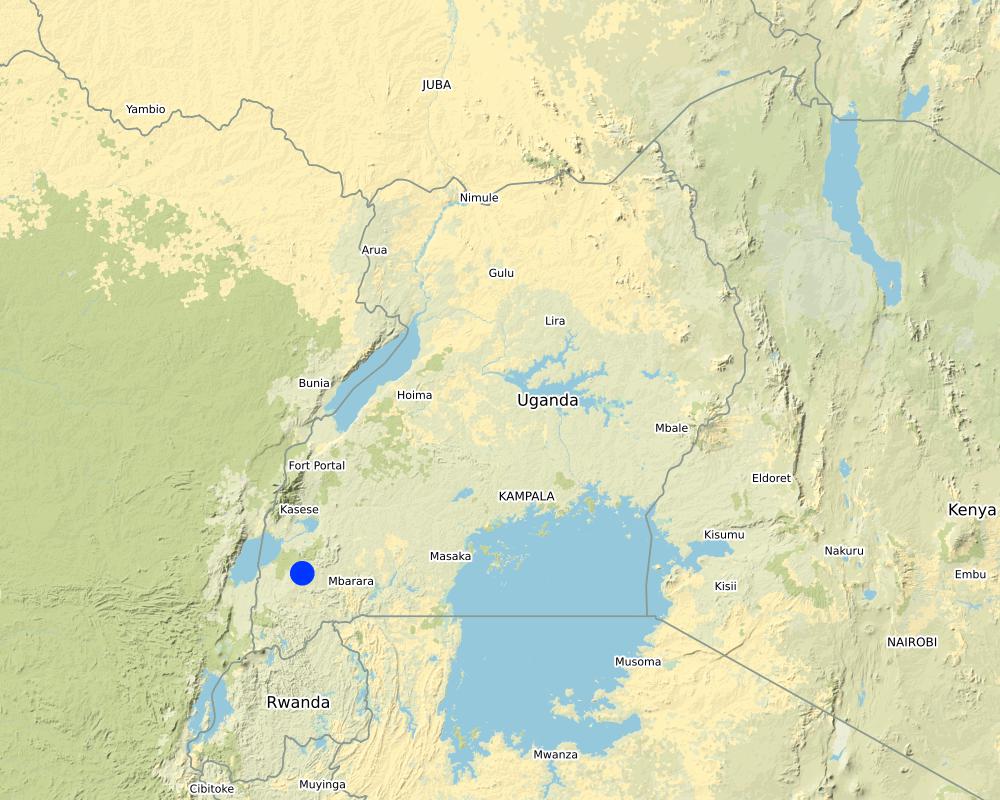Backyard fish farming in tarpaulin ponds for improved livelihood [Uganda]
- Creation:
- Update:
- Compiler: Aine Amon
- Editors: Drake Mubiru, Kamugisha Rick Nelson
- Reviewers: Nicole Harari, Udo Höggel
Okutunga Ebyenyanja omu ntundubale
technologies_3391 - Uganda
View sections
Expand all Collapse all1. General information
1.2 Contact details of resource persons and institutions involved in the assessment and documentation of the Technology
Key resource person(s)
land user:
David Mawanda
Uganda, Bushenyi, Kagoma
Uganda
Name of project which facilitated the documentation/ evaluation of the Technology (if relevant)
Scaling-up SLM practices by smallholder farmers (IFAD)Name of the institution(s) which facilitated the documentation/ evaluation of the Technology (if relevant)
National Agricultural Research Organisation (NARO) - Uganda1.3 Conditions regarding the use of data documented through WOCAT
When were the data compiled (in the field)?
23/01/2018
The compiler and key resource person(s) accept the conditions regarding the use of data documented through WOCAT:
Ja
1.4 Declaration on sustainability of the described Technology
Is the Technology described here problematic with regard to land degradation, so that it cannot be declared a sustainable land management technology?
Nee
2. Description of the SLM Technology
2.1 Short description of the Technology
Definition of the Technology:
A fish pond for intensive commercial fish farming is constructed in the backyard of the farmer's home for easy management. The pond is lined with a tarpaulin interior and is connected to a water source for water supply during the seasons of water scarcitiy.
2.2 Detailed description of the Technology
Description:
The backyard fish pond farming system is a simple commercial fish farming system established close to the farmers’ home stead. It is planned to ease management of rearing the fish and to minimize maintenance costs. The system is also designed to harvest rain water and overflow which eases filling and emptying of the pond with water. The walls of the ponds are lined with tarpaulin and the banks are strengthened with timber or brick work to prevent breaking of the walls. The three ponds in Bushenyi-Kigoma are located on a gentle slope and designed with a trench that feeds them with rain water from the rain harvest reservoir up slope. They were constructed in 2013 and are located a meter away from a live fence enclosing the farmer’s house. This makes it easy for the farmer to access, monitor and manage the fish ponds.
The establishment process for each pond is simple and may not require technical skills to set up the system. The activities involved include:
i.Excavation of the pond, which is best done during the dry season to avoid interruption by runoff.
ii.Strengthening of banks using timber and nails (some farmers use brinks, cement and sand)
iii.Lining of the water proof tarpaulin on the interior of the pond.
iv.Construction of a water channel from the water reservoir to the pond and fixing of overflow pipes at the deeper end of the ponds.
v.Filling the pond with water and applying animal dug to fertilize the ponds. This creates a favorable environment for growth of microorganisms and algae on which fish can feed.
vi.The fish fingerlings are introduced into the pond two weeks after fertilization with animal dug.
The maintenance activities include; cleaning of ponds from contamination of objects, changing of the pond water on a monthly basis to avoid contamination that may lead to infestation and application of organic fertilizers.
Establishment requires a hoe, panga, dibber, spade, wheel barrow, hammer and the trowel. The inputs include; timber, tarpaulin, cement, garters bricks, sand, nails, plastic pipe, water, animal dung, fish pellets and fish fingerlings. These where used to construct a pond 5 m × 4 m × 3 m i.e length × width × depth respectively, with a maximum carrying capacity of 500 cat fish.
The costs of setting up the system are relatively affordable to the average local people according to the farmer. The key determinants are hiring labor to excavate the ponds, construction of a water channel and stocking fish fingerlings which are all locally available. The maintenance activities involve daily feeding of fish, cleaning in case of contamination, changing the pond water every 3 months and harvesting of fish at 7 months of age. The farmer spends USD $ 164.65 on establishment of the pond system including, exaction costs, equipment, materials and stocking fingerlings (USD $ 0.033 each). The farmer spends USD$ 21.99 on premixed feeds before harvesting the fish after seven months. The cat fish are harvested with 3-5 kg liveweight after 7 months and sold at USD$ 2.75 to wholesale buyers from Kasese District.
The intensive fish farming system is designed to demand minimal labor for feeding the fish, cleaning the pond, replacing water and harvesting fish. The system is also adapted to water scarcity in the dry season since it is connected to a rain water harvest system; regular changing of pond water improves visibility, removes algae, replenishes oxygen and minimizes possible infections in the pond.
2.3 Photos of the Technology
2.4 Videos of the Technology
Comments, short description:
The Video shows the set up of the ponds but does not include the farmer's house because of the live fence separating the ponds from the house.
Date:
24/01/2018
Name of videographer:
Amon Aine
2.5 Country/ region/ locations where the Technology has been applied and which are covered by this assessment
Country:
Uganda
Region/ State/ Province:
Western Uganda, Bushenyi District
Further specification of location:
Nyabubare Sub county, Kigoma town
Comments:
The farm is 6Km from Ishaka Bushenyi along Bushenyi-Rubirizi highway.
Map
×2.6 Date of implementation
Indicate year of implementation:
2016
2.7 Introduction of the Technology
Specify how the Technology was introduced:
- through land users' innovation
- through projects/ external interventions
Comments (type of project, etc.):
Intensive back yard fish farming.
3. Classification of the SLM Technology
3.1 Main purpose(s) of the Technology
- improve production
- reduce, prevent, restore land degradation
- reduce risk of disasters
- adapt to climate change/ extremes and its impacts
- create beneficial economic impact
- Beauty
3.2 Current land use type(s) where the Technology is applied

Cropland
- Perennial (non-woody) cropping
Main crops (cash and food crops):
Bananas, yams and shrub fence
3.3 Further information about land use
Water supply for the land on which the Technology is applied:
- mixed rainfed-irrigated
Comments:
The farmer harvests roof top water and channels it into the ponds during times of water scarcity
Number of growing seasons per year:
- 2
Specify:
March - May & Sept - Nov
Livestock density (if relevant):
500 fish per 5m×4m×3m in length, width and depth respectively
3.4 SLM group to which the Technology belongs
- beekeeping, aquaculture, poultry, rabbit farming, silkworm farming, etc.
- home gardens
3.5 Spread of the Technology
Specify the spread of the Technology:
- applied at specific points/ concentrated on a small area
3.6 SLM measures comprising the Technology

structural measures
- S5: Dams, pans, ponds
3.7 Main types of land degradation addressed by the Technology

physical soil deterioration
- Pu: loss of bio-productive function due to other activities

other
Comments:
The intensive method utilizes small space for high quantity fish production and therefore reduces the conversion of large pieces of land to fish farming
3.8 Prevention, reduction, or restoration of land degradation
Specify the goal of the Technology with regard to land degradation:
- reduce land degradation
Comments:
The design promotes intensive methods to utilize small space for high quantity fish production and therefore reduces the conversion of large pieces of land to fish farming.
4. Technical specifications, implementation activities, inputs, and costs
4.1 Technical drawing of the Technology
4.2 Technical specifications/ explanations of technical drawing
The water ponds are constructed with 5m × 4m × 3 m i.e length × width × depth. The ponds are on a gentle slope a meter away from a live fence. The ponds are lined with a water proof tarpaulin. The banks are strengthened with wood fixed together with nails.
4.3 General information regarding the calculation of inputs and costs
Specify how costs and inputs were calculated:
- per Technology unit
Specify unit:
Pond
Specify volume, length, etc. (if relevant):
5m × 4m × 3 m i.e length × width × depth respectively
other/ national currency (specify):
Ugandan shilling
Indicate exchange rate from USD to local currency (if relevant): 1 USD =:
3650.0
Indicate average wage cost of hired labour per day:
10,000
4.4 Establishment activities
| Activity | Type of measure | Timing | |
|---|---|---|---|
| 1. | Excavation | Structural | In the dry season |
| 2. | Fixing of tarpaulin and timber on the banks | Structural | After excavation |
| 3. | Filling pond with water and fertilizing with animal dug | Management | After fixing walls |
| 4. | Stocking the pond | Other measures | 2 days after filling pond with water and fertilization |
| 5. | Connecting a water channel from the water reservoir with a pvc pipe at end the end leading to the pond | Structural | After excavation. |
4.5 Costs and inputs needed for establishment
| Specify input | Unit | Quantity | Costs per Unit | Total costs per input | % of costs borne by land users | |
|---|---|---|---|---|---|---|
| Labour | Construction labour | man day | 5.0 | 50000.0 | 250000.0 | 100.0 |
| Equipment | Hoe hire | per day | 500.0 | 5.0 | 2500.0 | 100.0 |
| Equipment | Panga hire | per day | 500.0 | 5.0 | 2500.0 | 100.0 |
| Equipment | Spade hire | per day | 500.0 | 5.0 | 2500.0 | 100.0 |
| Equipment | Hammer hire | per day | 500.0 | 5.0 | 2500.0 | 100.0 |
| Equipment | Wheel barrow hire | per day | 500.0 | 5.0 | 2500.0 | 100.0 |
| Equipment | Metallic tray | per day | 500.0 | 5.0 | 2500.0 | 100.0 |
| Plant material | Fish fingerlings | pieces | 500.0 | 500.0 | 250000.0 | 100.0 |
| Fertilizers and biocides | Animal Dung | kg | 50.0 | 120.0 | 6000.0 | 100.0 |
| Construction material | Tarpaulin | pieces | 1.0 | 45000.0 | 45000.0 | 100.0 |
| Construction material | Timber | pieces | 8.0 | 3000.0 | 24000.0 | 100.0 |
| Construction material | Nails | Kg | 0.5 | 8000.0 | 4000.0 | 100.0 |
| Construction material | Hose Pipe | Pieces | 2.0 | 5000.0 | 10000.0 | 100.0 |
| Other | Water | Liters | 500.0 | 10.0 | 5000.0 | 100.0 |
| Total costs for establishment of the Technology | 609000.0 | |||||
4.6 Maintenance/ recurrent activities
| Activity | Type of measure | Timing/ frequency | |
|---|---|---|---|
| 1. | Feeding | Management | Once daily |
| 2. | Cleaning | Management | Once a week |
| 3. | Changing the water | Management | Every three months |
| 4. | Harvesting | Management | Every 7months |
4.7 Costs and inputs needed for maintenance/ recurrent activities (per year)
| Specify input | Unit | Quantity | Costs per Unit | Total costs per input | % of costs borne by land users | |
|---|---|---|---|---|---|---|
| Labour | Cleaning | man day | 1.0 | 5000.0 | 5000.0 | 100.0 |
| Labour | Feeding | man day | 1.0 | 600000.0 | 600000.0 | 100.0 |
| Labour | Replacement of water | man day | 1.0 | 100000.0 | 100000.0 | 100.0 |
| Labour | Harvesting | manday | 2.0 | 5000.0 | 10000.0 | 100.0 |
| Equipment | Slasher | piece | 2.0 | 8000.0 | 16000.0 | 100.0 |
| Equipment | Hoe | piece | 2.0 | 15000.0 | 30000.0 | 100.0 |
| Equipment | Bucket | piece | 2.0 | 6000.0 | 12000.0 | 100.0 |
| Fertilizers and biocides | Cow dug | tones | 1.0 | 250000.0 | 250000.0 | 100.0 |
| Total costs for maintenance of the Technology | 1023000.0 | |||||
4.8 Most important factors affecting the costs
Describe the most determinate factors affecting the costs:
Excavation of ponds and stocking of fish fingerlings. Excavation is done once at the start of the project. The labour required for operation and maintenance is minimal compared to conventional fish farming methods.
5. Natural and human environment
5.1 Climate
Annual rainfall
- < 250 mm
- 251-500 mm
- 501-750 mm
- 751-1,000 mm
- 1,001-1,500 mm
- 1,501-2,000 mm
- 2,001-3,000 mm
- 3,001-4,000 mm
- > 4,000 mm
Specifications/ comments on rainfall:
The rain seasons are two i.e March-May, Sept-ov
Agro-climatic zone
- sub-humid
5.2 Topography
Slopes on average:
- flat (0-2%)
- gentle (3-5%)
- moderate (6-10%)
- rolling (11-15%)
- hilly (16-30%)
- steep (31-60%)
- very steep (>60%)
Landforms:
- plateau/plains
- ridges
- mountain slopes
- hill slopes
- footslopes
- valley floors
Altitudinal zone:
- 0-100 m a.s.l.
- 101-500 m a.s.l.
- 501-1,000 m a.s.l.
- 1,001-1,500 m a.s.l.
- 1,501-2,000 m a.s.l.
- 2,001-2,500 m a.s.l.
- 2,501-3,000 m a.s.l.
- 3,001-4,000 m a.s.l.
- > 4,000 m a.s.l.
Indicate if the Technology is specifically applied in:
- not relevant
5.3 Soils
Soil depth on average:
- very shallow (0-20 cm)
- shallow (21-50 cm)
- moderately deep (51-80 cm)
- deep (81-120 cm)
- very deep (> 120 cm)
Soil texture (topsoil):
- medium (loamy, silty)
Soil texture (> 20 cm below surface):
- medium (loamy, silty)
Topsoil organic matter:
- medium (1-3%)
5.4 Water availability and quality
Ground water table:
5-50 m
Availability of surface water:
medium
Water quality (untreated):
poor drinking water (treatment required)
Is water salinity a problem?
Ja
Specify:
Cat fish doesn't thrive well in saline waters, the longer the water stays in the pond the more salts it accumulates due to waste from fish and feeds being used hence need for replacement every three months.
Is flooding of the area occurring?
Nee
5.5 Biodiversity
Species diversity:
- high
Habitat diversity:
- medium
5.6 Characteristics of land users applying the Technology
Sedentary or nomadic:
- Sedentary
Market orientation of production system:
- commercial/ market
Off-farm income:
- 10-50% of all income
Relative level of wealth:
- rich
Individuals or groups:
- individual/ household
Level of mechanization:
- manual work
Gender:
- men
Age of land users:
- middle-aged
Indicate other relevant characteristics of the land users:
The project belongs to a household of 5 children and parents in their 45-50 years
5.7 Average area of land owned or leased by land users applying the Technology
- < 0.5 ha
- 0.5-1 ha
- 1-2 ha
- 2-5 ha
- 5-15 ha
- 15-50 ha
- 50-100 ha
- 100-500 ha
- 500-1,000 ha
- 1,000-10,000 ha
- > 10,000 ha
Is this considered small-, medium- or large-scale (referring to local context)?
- medium-scale
5.8 Land ownership, land use rights, and water use rights
Land ownership:
- state
- individual, titled
Land use rights:
- individual
Water use rights:
- communal (organized)
- individual
5.9 Access to services and infrastructure
health:
- poor
- moderate
- good
education:
- poor
- moderate
- good
technical assistance:
- poor
- moderate
- good
employment (e.g. off-farm):
- poor
- moderate
- good
markets:
- poor
- moderate
- good
energy:
- poor
- moderate
- good
roads and transport:
- poor
- moderate
- good
drinking water and sanitation:
- poor
- moderate
- good
financial services:
- poor
- moderate
- good
6. Impacts and concluding statements
6.1 On-site impacts the Technology has shown
Socio-economic impacts
Production
crop production
Comments/ specify:
Water from pond used for irrigation
Income and costs
expenses on agricultural inputs
Comments/ specify:
Less labour cots for the operation & maintenance
farm income
diversity of income sources
Comments/ specify:
Farmer has many other projects (piggery, bananas, yams)
Ecological impacts
Water cycle/ runoff
harvesting/ collection of water
Comments/ specify:
Water collected in ponds
surface runoff
Soil
soil moisture
soil cover
soil loss
Climate and disaster risk reduction
flood impacts
drought impacts
6.2 Off-site impacts the Technology has shown
water availability
Comments/ specify:
Harvesting of water for fish farming reduces the runoff and hence a reduction in the water volumes flowing down hill
damage on neighbours' fields
6.3 Exposure and sensitivity of the Technology to gradual climate change and climate-related extremes/ disasters (as perceived by land users)
Climate-related extremes (disasters)
Climatological disasters
| How does the Technology cope with it? | |
|---|---|
| drought | very well |
Comments:
During the dry season, the water harvested from the roof top is used to replenish the water in the ponds
6.4 Cost-benefit analysis
How do the benefits compare with the establishment costs (from land users’ perspective)?
Short-term returns:
positive
Long-term returns:
positive
How do the benefits compare with the maintenance/ recurrent costs (from land users' perspective)?
Short-term returns:
positive
Long-term returns:
very positive
6.5 Adoption of the Technology
- 10-50%
Of all those who have adopted the Technology, how many have did so spontaneously, i.e. without receiving any material incentives/ payments?
- 50-90%
6.6 Adaptation
Has the Technology been modified recently to adapt to changing conditions?
Ja
If yes, indicate to which changing conditions it was adapted:
- labour availability (e.g. due to migration)
Specify adaptation of the Technology (design, material/ species, etc.):
The system is designed to harvest water on roof tops and deliver it in the fishponds, Some of the harvested water is reserved for replenishing of water in the ponds during times of scarcity
6.7 Strengths/ advantages/ opportunities of the Technology
| Strengths/ advantages/ opportunities in the land user’s view |
|---|
| Easy management since most of the tedious work is at establishment |
| Easy to harvest the fish since many fish are keep in a small pond/tarpaulin |
| Strengths/ advantages/ opportunities in the compiler’s or other key resource person’s view |
|---|
| There is rady market for the fish |
| Rain Water harvesting reduces impacts of climate change on the fish production especially in the dry season/times of scarcity |
| Source of proteins for the public that buy the fish for sauce |
6.8 Weaknesses/ disadvantages/ risks of the Technology and ways of overcoming them
| Weaknesses/ disadvantages/ risks in the land user’s view | How can they be overcome? |
|---|---|
| At times of extreme dry season, the farmer may face challenges of water scarcity | Establishment of big enough water reservoirs |
| Weaknesses/ disadvantages/ risks in the compiler’s or other key resource person’s view | How can they be overcome? |
|---|---|
| Due to high stock ratio, the fish are prone to diseases/parasites in case of any break out | Reduction in the stocking rate, the farmer should farther maintain the hygiene and precaution in management |
7. References and links
7.1 Methods/ sources of information
- field visits, field surveys
1 farm
- interviews with land users
1 farmer
- compilation from reports and other existing documentation
1- a news paper that wrote about a similar pond system, in Masaka District
7.3 Links to relevant information which is available online
Title/ description:
Rear fish in your backyard with harvested rainwater
URL:
http://www.monitor.co.ug/Magazines/Farming/Rear-fish-backyard-harvested-rainwater/689860-2997914-vacgkk/index.html
Links and modules
Expand all Collapse allLinks
No links
Modules
No modules


